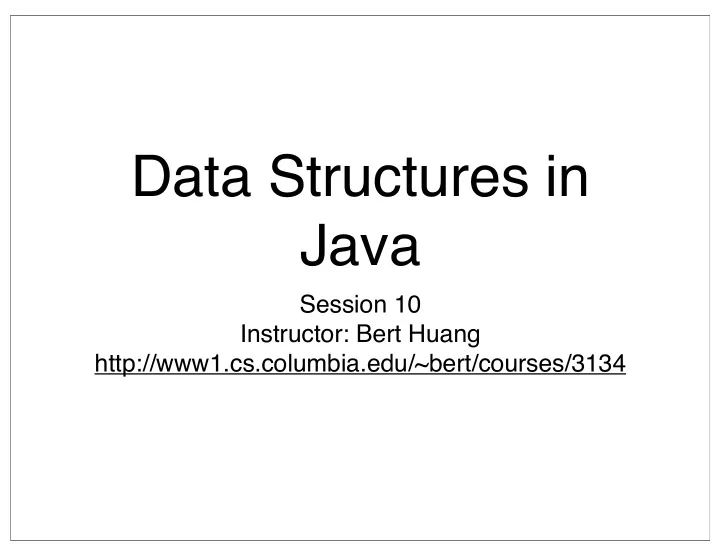

Data Structures in Java Session 10 Instructor: Bert Huang http://www1.cs.columbia.edu/~bert/courses/3134
Announcements • Homework 3 due 10/20
Review • AVL Trees • Single rotate for left-left imbalance • Double rotate for left-right imbalance • Running time Analysis • Depth always O(log N) • Constant cost for rotations
Today ʼ s Plan • Amortized Running time • Splay Trees • Tries
Amortized Running Time • So far, we measure the worst-case running time of each operation • Usually we perform many operations • Sometimes M O ( f ( N )) operations can run provably faster than O (M f ( N )) • Then we can guarantee better average running time, aka amortized
Comparing Models • Amortized and Average case average running time of many operations • Amortized and Standard: adversary chooses input values and operations • Average analysis, analyst chooses randomization scheme
Splay Trees • Like AVL trees, use the standard binary search tree property • After any operation on a node, make that node the new root of the tree • Make the node the root by repeating one of two moves that make the tree more spread out
Informal Justification • Similar to caching . • Heuristically, data that is accessed tends to be accessed often. • Easier to implement than AVL trees • No height bookkeeping
Easy cases • If node is root, do nothing • If node is child of root, do single AVL rotation • Otherwise, node has a grandparent, and there are two cases
Case 1: zig-zag a c b a b z c w w x y z x y • Use when the node is the right child of a left child (or left-right) • Double rotate, just like AVL tree
Case 2: zig-zig • We can ʼ t use the single-rotation strategy like AVL trees • Instead we use a different process, and we ʼ ll compare this to single-rotation
Case 2: zig-zig a c z b b w a c y x y z w x • Use when node is the right-right child (or left-left) • Reverse the order of grandparent->parent->node • Make it node->parent->grandparent
Case 2 versus Single Rotations 1 7 7 6 6 5 5 4 4 3 3 2 2 1 1 zig-zig single-rotate
Case 2 versus Single Rotations 2 7 7 6 6 5 5 4 4 1 1 2 3 3 2 zig-zig single-rotate
Case 2 versus Single Rotations 3 7 7 6 6 1 1 5 4 4 2 5 3 3 2 zig-zig single-rotate
Case 2 versus Single Rotations 4 1 7 1 6 6 7 4 5 2 4 5 3 3 2 zig-zig single-rotate
Splay Analysis (Informal) • We can make a chain by inserting nodes that make the tree its left child • Each of these operations is cheap • Then we can search for deepest node • Splay operation squishes the tree; can only bad operations once before they become cheap • M operations take O ( M log N ), so amortized O (log N ) per operation (fyi, not proved)
Prefix Trees (Tries) • Nicknamed “Trie”, short for re trie val • Efficiently store objects for fast retrieval via keys • Usually key is a String • Basic strategy: • split into sub-tries based on current letter
Trie Example • “cat”, “cow”, “dog”, “doberman”, “duck” Root c d a o o u duck cow cat g b doberman dog
Trie Analysis • In the worst case, inserting a key of length k or (looking up) is O(k) • This is not dependent on N (this is shocking!) • Much better than log(N) for huge data like dictionaries
Reading • Splay Trees: 4.5
Recommend
More recommend